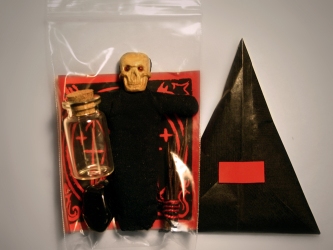Dolls

The need for a ‘protector’ is probably as old as human culture. Talismans made of clay, metal, stone, wood or natural objects, such as auspiciously shaped roots and healing herbs are means of protecting the wearer from the jealousy and bad intentions of others, ill luck, sickness and pain and even death itself. The art of talisman making is taken to the next level in the creation of dolls or idols, which are often filled or stuffed. Whilst the religious idols of saints are usually imovable, a doll can possess articulated limbs and thus may be animated. It is this aspect, which adds a more sinister touch, namely if the doll takes on a life of its own. The fear of dolls or similar objects is called Pediophobia and may be caused by incertainty pertaining to whether an object is alive or not.
The use of dolls for various magical or sorcerous purposes is characteristic for some folk religions. However, the same motivation can also be found with modern day action figures. The child within seeks an idol or protector, which can be touched and brought to concrete action according to one’s own will. It is also a means of exercising controll. In the fantasy of the child the doll can be a guide into a different world and can aid the child in the creation of its very own universe. Often one doll does not come or stay alone, as it will seek the company of other dolls. The doll may also become a status symbol, which is expressed to a larger extend in the need for collecting and assembling entire armies of dolls or figures.
Lastly dolls serve various educational purposes, e.g. for anatomical studies, training human interactions or be used in therapy, e.g. for training motor skills.
Examples from antiquity:
- Wooden paddle dolls found in Egyptian tombs dating to as early as 2000 BCE, featuring exaggerated female forms acting as fertility symbols, probably to guarantee eternal rebirth
- Dolls with movable limbs and removable clothing dating back to at least 200 BCE, e.g. Greek dolls made of clay and articulated at the hips and shoulders
- Greek dolls dating to 100 BCE were used by little girls as playthings
- dolls were found in the graves of Roman children
- younger members of Roman civilization dressed their dolls according to the latest fashions
- Roman rag dolls dating back to at least 300 BCE
African traditions:
- Akuaba are wooden ritual fertility dolls from Ghana
- the nkisi or bocio of West and Central Africa are magical figures inhabited by spirits
- the nkondi are a subclass of nkisi that are considered aggressive and often feature nails and mirrors
Asian traditions:
- traditional Japenese dolls date back to the Dogū figures (8000–200 BC) and Haniwa funerary figures (300-600 AD)
- During Hinamatsuri, the doll festival, are displayed hina dolls made of straw and wood, painted, and dressed in elaborate, many-layered textiles
- Daruma dolls are spherical dolls with red bodies and white faces without pupils, used as good luck charms and representing Bodhidharma, the East Indian founder of Zen
- Wooden Kokeshi dolls with no arms or legs, but large heads and cylindrical bodies, represent little girls
Native and Meso-American traditions:
- Hopi Kachina dolls are effigies made of cottonwood that embody the characteristics of the ceremonial Kachina, masked spirits of the Hopi Native American tribe and were meant to aid in learning the characteristics of each spirit
- Inuit dolls are made out of soapstone and bone, and often clothed with animal fur or skin, the traditional style of dress necessary to survive cold winters, wind and snow
- tea dolls of the Innu people were filled with tea for young girls to carry on long journeys
- traditional North American apple dolls have a head made from dried apples
- Sara Mama, the goddess of grain in Inca mythology, had her own dolls
- corn husk dolls are traditional Native American dolls made out of the dried leaves or husk of a corncob and traditionally lack a face
- early settlers also made rag dolls and carved wooden dolls, called Pennywoods
- ‘La última muñeca, or “the last doll”, is a tradition of the Quinceañera, the celebration of a girl’s fifteenth birthday in parts of Latin America
European traditions:
- in Germany clay dolls are found dating to the 13th century and wooden doll manufacturing from the 15th century onward
- detailed dolls, depicting naticvity scenes were manufactured in Italy by the 15th century
- Russian Matryoshka dolls, consisting of a set of hollow wooden figures that open up and nest inside each other, typically portraying traditional peasants
- peg wooden dolls were cheap and simply made, and were popular toys for poorer children in Europe going back to the 16th century
- poppet dolls (poppets) are used in European folk magic and witchcraft, to represent a person, for casting spells on that personthrough sympathetic magic
- kitchen witches are poppets originating in Northern Europe, resembling stereotypical witches or crones and is displayed in residential kitchens as a means to provide good luck and ward off bad spirits
- European poppet dolls may have influenced ‘voodoo dolls’ of Afro-American Hoodoo folk magic and aided misconceptions; voodoo dolls are not a feature of Haitian Vodou religion, but have been portrayed as such in popular culture, and stereotypical voodoo dolls are sold to tourists in Haiti
Examples from popular culture:
- Yolandi Visser appears as an animated sorcery doll on Die Antwoord’s third studio album Donkermag
Different from a doll, a puppet is an inanimate object or representational figure used in theatre, which is animated or manipulated by a puppeteer. It is not to be confused with the poppet of European witchcraft traditions.

Leave a comment